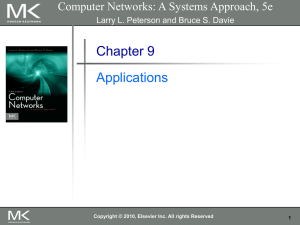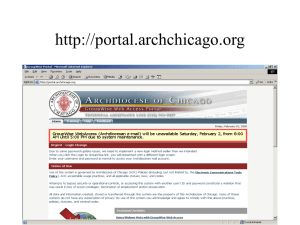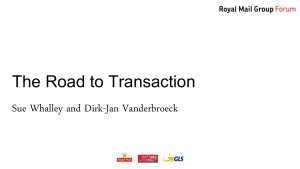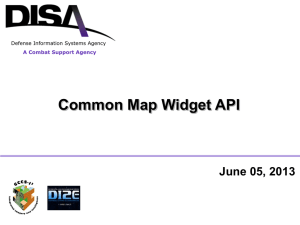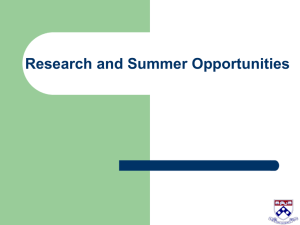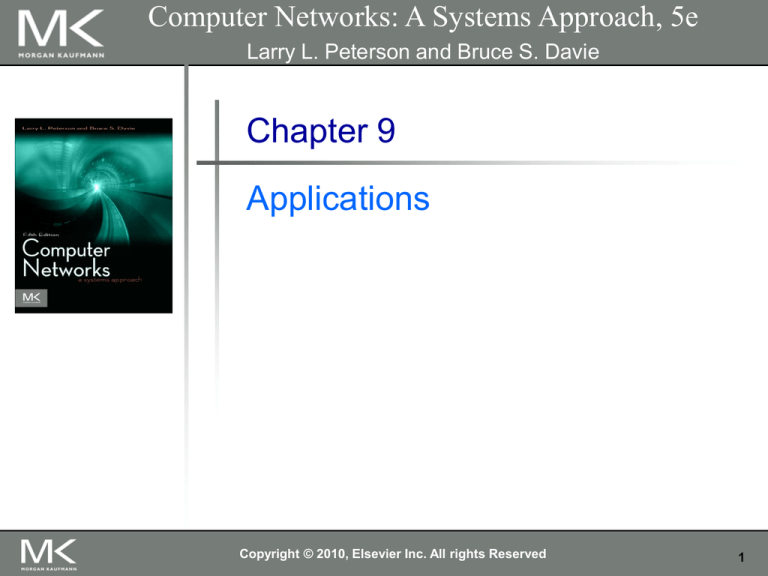
Computer Networks: A Systems Approach, 5e
Larry L. Peterson and Bruce S. Davie
Chapter 9
Applications
Copyright © 2010, Elsevier Inc. All rights Reserved
1
Chapter 9
Problem
Applications need their own protocols.
These applications are part network protocol (in
the sense that they exchange messages with
their peers on other machines) and part
traditional application program (in the sense that
they interact with the windowing system, the file
system, and ultimately, the user).
This chapter explores some of the most popular
network applications available today.
2
Chapter 9
Chapter Outline
Traditional Applications
Multimedia Applications
Infrastructure Services
Overlay Networks
3
Two of the most popular—
Chapter 9
Traditional Applications
The World Wide Web and
Email.
Broadly speaking, both of these applications use
the request/reply paradigm—users send
requests to servers, which then respond
accordingly.
4
Chapter 9
Traditional Applications
It is important to distinguish between application
programs and application protocols.
For example, the HyperText Transport Protocol
(HTTP) is an application protocol that is used to
retrieve Web pages from remote servers.
There can be many different application
programs—that is, Web clients like Internet
Explorer, Chrome, Firefox, and Safari—that
provide users with a different look and feel, but
all of them use the same HTTP protocol to
communicate with Web servers over the Internet.
5
Chapter 9
Traditional Applications
Two very widely-used, standardized application
protocols:
SMTP: Simple Mail Transfer Protocol is used to
exchange electronic mail.
HTTP: HyperText Transport Protocol is used to
communicate between Web browsers and Web
servers.
6
Chapter 9
Traditional Applications
Electronic Mail (SMTP, MIME, IMAP)
Email is one of the oldest network applications
It is important
(1) to distinguish the user interface (i.e., your mail
reader) from the underlying message transfer
protocols (such as SMTP or IMAP), and
(2) to distinguish between this transfer protocol and a
companion protocol (RFC 822 and MIME) that defines
the format of the messages being exchanged
7
Chapter 9
Traditional Applications
Electronic Mail (SMTP, MIME, IMAP)
Message Format
RFC 822 defines messages to have two parts: a header and
a body. Both parts are represented in ASCII text.
Originally, the body was assumed to be simple text. This is
still the case, although RFC 822 has been augmented by
MIME to allow the message body to carry all sorts of data.
This data is still represented as ASCII text, but because it
may be an encoded version of, say, a JPEG image, it’s not
necessarily readable by human users.
The message header is a series of <CRLF>-terminated lines.
(<CRLF> stands for carriage-return+ line-feed, which are a
pair of ASCII control characters often used to indicate the end
of a line of text.)
8
Chapter 9
Traditional Applications
Electronic Mail (SMTP, MIME, IMAP)
Message Format
The header is separated from the message body by a blank
line. Each header line contains a type and value separated by
a colon.
Many of these header lines are familiar to users since they
are asked to fill them out when they compose an email
message.
RFC 822 was extended in 1993 (and updated quite a few
times since then) to allow email messages to carry many
different types of data: audio, video, images, PDF documents,
and so on.
9
Chapter 9
Traditional Applications
Electronic Mail (SMTP, MIME, IMAP)
Message Format
MIME consists of three basic pieces.
The first piece is a collection of header lines that augment the original
set defined by RFC 822.
These header lines describe, in various ways, the data being
carried in the message body. They include MIME-Version: (the
version of MIME being used), Content-Description: (a humanreadable description of what’s in the message, analogous to the
Subject: line), Content-Type: (the type of data contained in the
message), and Content-Transfer- Encoding (how the data in the
message body is encoded).
The second piece is definitions for a set of content types (and
subtypes). For example, MIME defines two different still image types,
denoted image/gif and image/jpeg, each with the obvious meaning.
The third piece is a way to encode the various data types so they can
be shipped in an ASCII email message.
10
Chapter 9
Traditional Applications
Electronic Mail (SMTP, MIME, IMAP)
Message Transfer
For many years, the majority of email was moved from host to
host using only SMTP.
While SMTP continues to play a central role, it is now just one
email protocol of several,
IMAP and POP being two other important protocols for
retrieving mail messages.
11
Chapter 9
Traditional Applications
Electronic Mail (SMTP, MIME, IMAP)
Message Transfer
To place SMTP in the right context, we need to identify the
key players.
First, users interact with a mail reader when they compose,
file, search, and read their email.
There are countless mail readers available, just like there are many
Web browsers to choose from.
In the early days of the Internet, users typically logged into the machine
on which their mailbox resided, and the mail reader they invoked was a
local application program that extracted messages from the file system.
Today, of course, users remotely access their mailbox from their laptop
or smartphone; they do not first log into the host that stores their mail (a
mail server).
12
Chapter 9
Traditional Applications
Electronic Mail (SMTP, MIME, IMAP)
Message Transfer
To place SMTP in the right context, we need to identify the
key players.
Second, there is a mail daemon (or process) running on each
host that holds a mailbox.
You can think of this process, also called a message transfer agent
(MTA), as playing the role of a post office: users (or their mail readers)
give the daemon messages they want to send to other users, the
daemon uses SMTP running over TCP to transmit the message to a
daemon running on another machine, and the daemon puts incoming
messages into the user’s mailbox (where that user’s mail reader can
later find it).
Since SMTP is a protocol that anyone could implement, in theory there
could be many different implementations of the mail daemon.
13
Chapter 9
Traditional Applications
Electronic Mail (SMTP, MIME, IMAP)
Message Transfer
While it is certainly possible that the MTA on a sender’s
machine establishes an SMTP/TCP connection to the MTA
on the recipient’s mail server, in many cases the mail
traverses one or more mail gateways on its route from the
sender’s host to the receiver’s host.
Like the end hosts, these gateways also run a message
transfer agent process.
It’s not an accident that these intermediate nodes are called
“gateways” since their job is to store and forward email
messages, much like an “IP gateway” (which we have
referred to as a router) stores and forwards IP datagrams.
14
Chapter 9
Traditional Applications
Electronic Mail (SMTP, MIME, IMAP)
Message Transfer (contd.)
The only difference is that a mail gateway typically buffers
messages on disk and is willing to try retransmitting them to
the next machine for several days, while an IP router buffers
datagrams in memory and is only willing to retry transmitting
them for a fraction of a second.
15
Chapter 9
Traditional Applications
Electronic Mail (SMTP, MIME, IMAP)
Mail Reader
The final step is for the user to actually retrieve his or her
messages from the mailbox, read them, reply to them, and
possibly save a copy for future reference.
The user performs all these actions by interacting with a mail
reader.
As pointed out earlier, this reader was originally just a
program running on the same machine as the user’s mailbox,
in which case it could simply read and write the file that
implements the mailbox.
This was the common case in the pre-laptop era.
16
Chapter 9
Traditional Applications
Electronic Mail (SMTP, MIME, IMAP)
Mail Reader
Today, most often the user accesses his or her mailbox from
a remote machine using yet another protocol, such as the
Post Office Protocol (POP) or the Internet Message Access
Protocol (IMAP).
It is beyond the scope of this book to discuss the user
interface aspects of the mail reader, but it is definitely within
our scope to talk about the access protocol.
17
Chapter 9
Traditional Applications
Electronic Mail (SMTP, MIME, IMAP)
Mail Reader
IMAP is similar to SMTP in many ways.
It is a client/server protocol running over TCP, where the
client (running on the user’s desktop machine) issues
commands in the form of <CRLF>-terminated ASCII text lines
and the mail server (running on the machine that maintains
the user’s mailbox) responds in-kind.
The exchange begins with the client authenticating him or
herself, and identifying the mailbox he or she wants to
access.
18
Chapter 9
Traditional Applications
Electronic Mail (SMTP, MIME, IMAP)
IMAP State Transition Diagram
19
World Wide Web
The World Wide Web has been so successful and has made the Internet accessible to so many people that
sometimes it seems to be synonymous with the Internet.
In fact, the design of the system that became the Web started around 1989, long after the Internet had
become a widely deployed system.
The original goal of the Web was to find a way to organize and retrieve information, drawing on ideas about
hypertext—interlinked documents—that had been around since at least the 1960s.
Chapter 9
Traditional Applications
20
Chapter 9
Traditional Applications
World Wide Web
The core idea of hypertext is that one document can
link to another document, and the protocol (HTTP)
and document language (HTML) were designed to
meet that goal.
One helpful way to think of the Web is as a set of
cooperating clients and servers, all of whom speak the
same language: HTTP.
Most people are exposed to the Web through a
graphical client program, or Web browser, like Safari,
Chrome, Firefox or Internet Explorer.
21
Chapter 9
Traditional Applications
World Wide Web
Clearly, if you want to organize information into a
system of linked documents or objects, you need to
be able to retrieve one document to get started.
Hence, any Web browser has a function that allows
the user to obtain an object by “opening a URL.”
URLs (Uniform Resource Locators) are so familiar to
most of us by now that it’s easy to forget that they
haven’t been around forever.
They provide information that allows objects on the
Web to be located, and they look like the following:
http://www.cs.princeton.edu/index.html
22
Chapter 9
Traditional Applications
World Wide Web
If you opened that particular URL, your Web browser
would open a TCP connection to the Web server at a
machine called www.cs.princeton.edu and
immediately retrieve and display the file called
index.html.
Most files on the Web contain images and text and
many have other objects such as audio and video
clips, pieces of code, etc.
They also frequently include URLs that point to other
files that may be located on other machines, which is
the core of the “hypertext” part of HTTP and HTML.
23
Chapter 9
Traditional Applications
World Wide Web
When you ask your browser to view a page, your browser (the
client) fetches the page from the server using HTTP running over
TCP.
Like SMTP, HTTP is a text oriented protocol.
At its core, HTTP is a request/response protocol, where every
message has the general form
START_LINE <CRLF>
MESSAGE_HEADER <CRLF>
<CRLF>
MESSAGE_BODY <CRLF>
where as before,<CRLF>stands for carriage-return-line-feed.The
first line (START LINE)
indicates whether this is a request message or a response
message.
24
Chapter 9
Traditional Applications
World Wide Web
Request Messages
The first line of an HTTP request message specifies three
things: the operation to be performed, the Web page the
operation should be performed on, and the version of HTTP
being used.
Although HTTP defines a wide assortment of possible
request operations—including “write” operations that allow a
Web page to be posted on a server—the two most common
operations are GET (fetch the specified Web page) and
HEAD (fetch status information about the specified Web
page).
25
Chapter 9
Traditional Applications
World Wide Web
Request Messages
HTTP request operations
26
Chapter 9
Traditional Applications
World Wide Web
Response Messages
Like request messages, response messages begin with a
single START LINE.
In this case, the line specifies the version of HTTP being
used, a three-digit code indicating whether or not the request
was successful, and a text string giving the reason for the
response.
27
Chapter 9
Traditional Applications
World Wide Web
Response Messages
Five types of HTTP result codes
28
Chapter 9
Traditional Applications
World Wide Web
Uniform Resource Identifiers
The URLs that HTTP uses as addresses are one type of
Uniform Resource Identifier (URI).
A URI is a character string that identifies a resource, where a
resource can be anything that has identity, such as a
document, an image, or a service.
The format of URIs allows various more-specialized kinds of
resource identifiers to be incorporated into the URI space of
identifiers.
The first part of a URI is a scheme that names a particular
way of identifying a certain kind of resource, such as mailto
for email addresses or file for file names.
The second part of a URI, separated from the first part by a
colon, is the scheme-specific part.
29
Chapter 9
Traditional Applications
World Wide Web
TCP Connections
The original version of HTTP (1.0) established a separate
TCP connection for each data item retrieved from the server.
It’s not too hard to see how this was a very inefficient
mechanism: connection setup and teardown messages had
to be exchanged between the client and server even if all the
client wanted to do was verify that it had the most recent copy
of a page.
Thus, retrieving a page that included some text and a dozen
icons or other small graphics would result in 13 separate TCP
connections being established and closed.
30
Chapter 9
Traditional Applications
World Wide Web
TCP Connections
To overcome this situation, HTTP version 1.1 introduced
persistent connections— the client and server can exchange
multiple request/response messages over the same TCP
connection.
Persistent connections have many advantages.
First, they obviously eliminate the connection setup overhead, thereby
reducing the load on the server, the load on the network caused by the
additional TCP packets, and the delay perceived by the user.
Second, because a client can send multiple request messages down a
single TCP connection, TCP’s congestion window mechanism is able to
operate more efficiently.
This is because it’s not necessary to go through the slow start
phase for each page.
31
Chapter 9
Traditional Applications
World Wide Web
TCP Connections
HTTP 1.0 behavior
32
Chapter 9
Traditional Applications
World Wide Web
TCP Connections
HTTP 1.1 behavior with persistent connections
33
Chapter 9
Traditional Applications
World Wide Web
Caching
One of the most active areas of research (and
entrepreneurship) in the Internet today is how to effectively
cache Web pages.
Caching has many benefits. From the client’s perspective, a
page that can be retrieved from a nearby cache can be
displayed much more quickly than if it has to be fetched from
across the world.
From the server’s perspective, having a cache intercept and
satisfy a request reduces the load on the server.
34
World Wide Web
Chapter 9
Traditional Applications
Caching
Caching can be implemented in many different places. For
example, a user’s browser can cache recently accessed
pages, and simply display the cached copy if the user visits
the same page again.
As another example, a site can support a single site-wide
cache.
This allows users to take advantage of pages previously
downloaded by other users.
Closer to the middle of the Internet, ISPs can cache pages.
Note that in the second case, the users within the site most
likely know what machine is caching pages on behalf of the
site, and they configure their browsers to connect directly to
the caching host. This node is sometimes called a proxy
35
Web Services
Chapter 9
Traditional Applications
Much of the motivation for enabling direct applicationto-application communication comes from the
business world.
Historically, interactions between enterprises—
businesses or other organizations—have involved
some manual steps such as filling out an order form or
making a phone call to determine whether some
product is in stock.
Even within a single enterprise it is common to have
manual steps between software systems that cannot
interact directly because they were developed
independently.
36
Chapter 9
Traditional Applications
Web Services
Increasingly such manual interactions are being
replaced with direct application-to application
interaction.
An ordering application at enterprise A would send a
message to an order fulfillment application at
enterprise B, which would respond immediately
indicating whether the order can be filled.
Perhaps, if the order cannot be filled by B, the
application at A would immediately order from another
supplier, or solicit bids from a collection of suppliers.
37
Chapter 9
Traditional Applications
Web Services
Two architectures have been advocated as solutions
to this problem.
Both architectures are called Web Services, taking
their name from the term for the individual applications
that offer a remotely-accessible service to client
applications to form network applications.
The terms used as informal shorthand to distinguish
the two Web Services architectures are SOAP and
REST (as in, “the SOAP vs. REST debate”).
38
Chapter 9
Traditional Applications
Web Services
The SOAP architecture’s approach to the problem is
to make it feasible, at least in theory, to generate
protocols that are customized to each network
application.
The key elements of the approach are a framework for
protocol specification, software toolkits for
automatically generating protocol implementations
from the specifications, and modular partial
specifications that can be reused across protocols.
39
Chapter 9
Traditional Applications
Web Services
The REST architecture’s approach to the problem is
to regard individual Web Services as World Wide Web
resources—identified by URIs and accessed via
HTTP.
Essentially, the REST architecture is just the Web
architecture.
The Web architecture’s strengths include stability and
a demonstrated scalability (in the network-size sense).
40
Chapter 9
Traditional Applications
Custom Application Protocols (WSDL, SOAP)
The architecture informally referred to as SOAP is
based on Web Services Description Language
(WSDL) and SOAP.4
Both of these standards are issued by the World Wide
Web Consortium (W3C).
This is the architecture that people usually mean
when they use the term Web Services without any
preceding qualifier.
41
Chapter 9
Multimedia Applications
Just like the traditional applications described
earlier in this chapter, multimedia applications
such as telephony and videoconferencing need
their own protocols.
We have already seen a number of protocols
that multimedia applications use.
The Real-Time Transport Protocol (RTP)
provides many of the functions that are common
to multimedia applications such as conveying
timing information and identifying the coding
schemes and media types of an application.
42
Chapter 9
Multimedia Applications
The Resource Reservation Protocol, RSVP can
be used to request the allocation of resources in
the network so that the desired quality of service
(QoS) can be provided to an application.
In addition to these protocols for multimedia
transport and resource allocation, many
multimedia applications also need a signalling or
session control protocol.
For example, suppose that we wanted to be able
to make telephone calls across the internet
(“voice over IP” or VOIP).
43
Chapter 9
Multimedia Applications
Session Control and Call Control (SDP, SIP, H.323)
To understand some of the issues of session control, consider
the following problem.
Suppose you want to hold a videoconference at a certain time and make it
available to a wide number of participants. Perhaps you have decided to
encode the video stream using the MPEG-2 standard, to use the multicast IP
address 224.1.1.1 for transmission of the data, and to send it using RTP over
UDP port number 4000.
How would you make all that information available to the intended
participants?
One way would be to put all that information in an email and send it out, but
ideally there should be a standard format and protocol for disseminating this
sort of information.
44
Chapter 9
Multimedia Applications
Session Control and Call Control (SDP, SIP, H.323)
The IETF has defined protocols for just this purpose.
The protocols that have been defined include
SDP (Session Description Protocol)
SAP (Session Announcement Protocol)
SIP (Session Initiation Protocol)
SCCP (Simple Conference Control Protocol)
45
Chapter 9
Multimedia Applications
Session Description Protocol (SDP)
The Session Description Protocol (SDP) is a rather general
protocol that can be used in a variety of situations and is typically
used in conjunction with one or more other protocols (e.g., SIP).
It conveys the following information:
The name and purpose of the session
Start and end times for the session
The media types (e.g. audio, video) that comprise the session
Detailed information needed to receive the session (e.g. the multicast
address to which data will be sent, the transport protocol to be used, the port
numbers, the encoding scheme, etc.)
46
Chapter 9
Multimedia Applications
SIP
SIP is an application layer protocol that bears a certain
resemblance to HTTP, being based on a similar
request/response model.
However, it is designed with rather different sorts of applications
in mind, and thus provides quite different capabilities than HTTP.
47
Chapter 9
Multimedia Applications
SIP
The capabilities provided by SIP can be grouped into five
categories:
User location: determining the correct device with which to communicate to
reach a particular user;
User availability: determining if the user is willing or able to take part in a
particular communication session;
User capabilities: determining such items as the choice of media and coding
scheme to use;
Session setup: establishing session parameters such as port numbers to be
used by the communicating parties;
Session management: a range of functions including transferring sessions
(e.g. to implement “call forwarding”) and modifying session parameters.
48
Chapter 9
Multimedia Applications
SIP
Establishing communication
through SIP proxies.
49
Chapter 9
Multimedia Applications
SIP
Message flow for a basic SIP session
50
Chapter 9
Infrastructure Services
There are some protocols that are essential to the
smooth running of the Internet, but that don’t fit neatly
into the strictly layered model.
One of these is the Domain Name System (DNS)—not
an application that users normally invoke explicitly, but
rather a service that almost all other applications depend
upon.
This is because the name service is used to translate
host names into host addresses; the existence of such
an application allows the users of other applications to
refer to remote hosts by name rather than by address.
51
Chapter 9
Infrastructure Services
Name Service (DNS)
In most of this book, we have been using addresses to identify
hosts.
While perfectly suited for processing by routers, addresses are
not exactly user-friendly.
It is for this reason that a unique name is also typically assigned
to each host in a network.
Host names differ from host addresses in two important ways.
First, they are usually of variable length and mnemonic, thereby making them
easier for humans to remember.
Second, names typically contain no information that helps the network locate
(route packets toward) the host.
52
Chapter 9
Infrastructure Services
Name Service (DNS)
We first introduce some basic terminology.
First, a name space defines the set of possible names.
A name space can be either flat (names are not divisible into components), or it can be
hierarchical (Unix file names are an obvious example).
Second, the naming system maintains a collection of bindings of names to
values. The value can be anything we want the naming system to return
when presented with a name; in many cases it is an address.
Finally, a resolution mechanism is a procedure that, when invoked with a
name, returns the corresponding value. A name server is a specific
implementation of a resolution mechanism that is available on a network and
that can be queried by sending it a message.
53
Chapter 9
Infrastructure Services
Name Service (DNS)
Names translated into addresses,
where the numbers 1–5 show the
sequence of steps in the process
54
Chapter 9
Infrastructure Services
Domain Hierarchy
DNS implements a hierarchical name space for Internet objects.
Unlike Unix file names, which are processed from left to right with
the naming components separated with slashes, DNS names are
processed from right to left and use periods as the separator.
Like the Unix file hierarchy, the DNS hierarchy can be visualized
as a tree, where each node in the tree corresponds to a domain,
and the leaves in the tree correspond to the hosts being named.
55
Chapter 9
Infrastructure Services
Domain Hierarchy
Example of a domain hierarchy
56
Chapter 9
Infrastructure Services
Name Servers
The complete domain name hierarchy exists only in the abstract.
We now turn our attention to the question of how this hierarchy is
actually implemented.
The first step is to partition the hierarchy into subtrees called
zones.
Each zone can be thought of as corresponding to some
administrative authority that is responsible for that portion of the
hierarchy.
For example, the top level of the hierarchy forms a zone that is
managed by the Internet Corporation for Assigned Names and
Numbers (ICANN).
57
Chapter 9
Name Servers
Partition hierarchy into zones
edu
princeton … mit
cs
ee
com
gov
cisco … yahoo nasa … nsf
mil
org
arpa … navy
acm … ieee
uk
fr
physics
ux01 ux04
•
net
Each zone
implemented by two or
more name servers
Root
name server
Princeton
name server
CS
name server
…
…
Cisco
name server
EE
name server
58
Each name server maintains a collection of resource
records
Chapter 9
Infrastructure Services
(Name, Value, Type, Class, TTL)
Name/Value: not necessarily host names to IP
addresses
Type
A: Address record value gives IP address bound to name
NS: Value gives domain name for host running name server that
knows how to resolve names within specified domain.
CNAME: Value gives canonical name for particlular host; used to
define aliases.
MX: Value gives domain name for host running mail server that
accepts messages for specified domain.
Class: allow other entities to define types
TTL: how long the resource record is valid
59
Chapter 9
Infrastructure Services
Root Server
(princeton.edu, cit.princeton.edu, NS, IN)
(cit.princeton.edu, 128.196.128.233, A, IN)
(cisco.com, thumper.cisco.com, NS, IN)
(thumper.ciscoe.com, 128.96.32.20, A, IN)
…
60
Chapter 9
Infrastructure Services
Intermediate Zone-Princeton Server
(cs.princeton.edu, optima.cs.princeton.edu, NS, IN)
(optima.cs.princeton.edu, 192.12.69.5, A, IN)
(ee.princeton.edu, helios.ee.princeton.edu, NS, IN)
(helios.ee.princeton.edu, 128.196.28.166, A, IN)
(jupiter.physics.princeton.edu, 128.196.4.1, A, IN)
(saturn.physics.princeton.edu, 128.196.4.2, A, IN)
(mars.physics.princeton.edu, 128.196.4.3, A, IN)
(venus.physics.princeton.edu, 128.196.4.4, A, IN)
61
Chapter 9
Infrastructure Services
Local Zone: CS Server
(cs.princeton.edu, optima.cs.princeton.edu, MX, IN)
(cheltenham.cs.princeton.edu, 192.12.69.60, A, IN)
(che.cs.princeton.edu, cheltenham.cs.princeton.edu,
CNAME, IN)
(optima.cs.princeton.edu, 192.12.69.5, A, IN)
(opt.cs.princeton.edu, optima.cs.princeton.edu,
CNAME, IN)
(baskerville.cs.princeton.edu, 192.12.69.35, A, IN)
(bas.cs.princeton.edu, baskerville.cs.princeton.edu,
CNAME, IN)
62
Chapter 9
Infrastructure Services
Name Resolution
Name resolution in practice, where the numbers 1–
10 show the sequence of steps in the process.
63
Chapter 9
Infrastructure Services
Network Management
A network is a complex system, both in terms of the number of
nodes that are involved and in terms of the suite of protocols that
can be running on any one node.
Even if you restrict yourself to worrying about the nodes within a
single administrative domain, such as a campus, there might be
dozens of routers and hundreds—or even thousands—of hosts
to keep track of. If you think about all the state that is maintained
and manipulated on any one of those nodes—for example,
address translation tables, routing tables, TCP connection state,
and so on—then it is easy to become depressed about the
prospect of having to manage all of this information
64
Chapter 9
Infrastructure Services
Network Management
The most widely used protocol for this purpose is the Simple
Network Management Protocol (SNMP).
SNMP is essentially a specialized request/reply protocol that
supports two kinds of request messages: GET and SET.
The former is used to retrieve a piece of state from some node,
and the latter is used to store a new piece of state in some node.
MIB II –RFC specified format for template specified by vendor. If
a value from the template is supplied to the node, firmware in the
node decodes the number string into a value either in the
configuration memory or a real-time value from the operating
system, such as the buffer state, etc.
Information grouped by function: System, Interfaces, ARP
table,IP values, TCP statistics, UDP statistics, ICMP, EGP,
SNMP
65
Chapter 9
Infrastructure Services
SNMP is used in the obvious way.
A system administrator interacts with a client program that displays
information about the network.
This client program usually has a graphical interface. Whenever the
administrator selects a certain piece of information that he or she wants to
see, the client program uses SNMP to request that information from the node
in question. (SNMP runs on top of UDP.)
An SNMP server running on that node receives the request, locates the
appropriate piece of information, and returns it to the client program, which
then displays it to the user.
Request syntax is ASN.1 BER
EX: The string 1.3.6.1.2.4.3 points to the real-time value IPinReceives, The string 1.3.6.1.2
refers to the specific hardware being monitored and is provided by the vendor. The 4 refers
to the IP group and the 3 refers to the third value in the group.
GET-NEXT
Functions as a GET but returns the string pointing to the next possible MIB
value in addition to the value of the string in the GET-NEXT.
66
Chapter 9
Overlay Network
In the last few years, the distinction between packet
forwarding and application processing has become less
clear.
New applications are being distributed across the
Internet, and in many cases, these applications make
their own forwarding decisions.
These new hybrid applications can sometimes be
implemented by extending traditional routers and
switches to support a modest amount of applicationspecific processing.
For example, so called level-7 switches sit in front of
server clusters and forward HTTP requests to a specific
server based on the requested URL.
67
However, overlay networks are quickly emerging as the
mechanism of choice for introducing new functionality
into the Internet
You can think of an overlay as a logical network
implemented on top of a some underlying network.
Chapter 9
Overlay Network
By this definition, the Internet started out as an overlay network
on top of the links provided by the old telephone network
Each node in the overlay also exists in the underlying
network; it processes and forwards packets in an
application-specific way.
The links that connect the overlay nodes are
implemented as tunnels through the underlying network.
68
Chapter 9
Overlay Network
Overlay network layered on top of a
physical network
69
Chapter 9
Overlay Network
Overlay nodes tunnel through physical
nodes
70
Chapter 9
Overlay Network
Routing Overlays
The simplest kind of overlay is one that exists purely
to support an alternative routing strategy; no
additional application-level processing is performed at
the overlay nodes.
You can view a virtual private network as an example
of a routing overlay.
In this particular case, the overlay is said to use “IP
tunnels”, and the ability to utilize these VPNs is
supported in many commercial routers.
71
Chapter 9
Overlay Network
Routing Overlays
Suppose, however, you wanted to use a routing
algorithm that commercial router vendors were not
willing to include in their products.
How would you go about doing it?
You could simply run your algorithm on a collection of end
hosts, and tunnel through the Internet routers.
These hosts would behave like routers in the overlay network:
as hosts they are probably connected to the Internet by only
one physical link, but as a node in the overlay they would be
connected to multiple neighbors via tunnels.
72
Chapter 9
Overlay Network
Routing Overlays
Experimental Versions of IP
Overlays are ideal for deploying experimental versions of IP
that you hope will eventually take over the world.
For example, IP multicast started off as an extension to IP
and even today is not enabled in many Internet routers.
The Mbone (multicast backbone) was an overlay network that
implemented IP multicast on top of the unicast routing
provided by the Internet.
A number of multimedia conference tools were developed for
and deployed on the Mbone.
For example, IETF meetings—which are a week long and
attract thousands of participants—were for many years
broadcast over the MBone.
73
Chapter 9
Overlay Network
Routing Overlays
End System Multicast
Although IP multicast is popular with researchers and certain
segments of the networking community, its deployment in the
global internet has been limited at best.
In response, multicast-based applications like
videoconferencing have recently turned to an alternative
strategy, called end system multicast.
The idea of end system multicast is to accept that IP multicast
will never become ubiquitous, and to instead let the end hosts
that are participating in a particular multicast-based
application implement their own multicast trees.
74
Chapter 9
Overlay Network
Routing Overlays
End System Multicast
(a) depicts an example physical topology, where R1 and
R2 are routers connected by a low-bandwidth
transcontinental link; A, B, C, and D are end hosts; and
link delays are given as edge weights. Assuming A wants
to send a multicast message to the other three hosts,
(b) shows how naive unicast transmission would
work. This is clearly undesirable because the same
message must traverse the link A–R1 three times, and two
copies of the message traverse R1–R2.
(c) depicts the IP multicast tree constructed by DVMRP.
Clearly, this approach eliminates the redundant
messages. Without support from the routers, however, the
best one can hope for with end system multicast is a tree
similar to the one shown in (d). End system multicast
defines an architecture for constructing this tree.
75
Chapter 9
Overlay Network
Routing Overlays
End System Multicast
The general approach is to support multiple levels of overlay
networks, each of which extracts a subgraph from the overlay
below it, until we have selected the subgraph that the
application expects.
For end system multicast in particular, this happens in two
stages: first we construct a simple mesh overlay on top of the
fully connected Internet, and then we select a multicast tree
within this mesh.
76
Chapter 9
Overlay Network
Routing Overlays
End System Multicast
Multicast tree embedded in an overlay
mesh
77
Chapter 9
Overlay Network
Resilient Overlay Networks
Another function that
can be performed by an
overlay is to find
alternative routes for
traditional unicast
applications.
Such overlays exploit
the observation that the
triangle inequality does
not hold in the Internet
78
Chapter 9
Overlay Network
Peer-to-peer Networks
Music-sharing applications like Napster and KaZaA
introduced the term “peer-to-peer” into the popular
vernacular.
Attributes like decentralized and selforganizing are mentioned when discussing
peer-to-peer networks, meaning that individual
nodes organize themselves into a network
without any centralized coordination
79
Chapter 9
Overlay Network
Peer-to-peer Networks
What’s interesting about peer-to-peer networks?
One answer is that both the process of locating an object of
interest and the process of downloading that object onto your
local machine happen without your having to contact a
centralized authority, and at the same time, the system is
able to scale to millions of nodes.
A peer-to-peer system that can accomplish these two tasks in
a decentralized manner turns out to be an overlay network,
where the nodes are those hosts that are willing to share
objects of interest (e.g., music and other assorted files), and
the links (tunnels) connecting these nodes represent the
sequence of machines that you have to visit to track down the
object you want.
80
Chapter 9
Overlay Network
Peer-to-peer Networks
Gnutella
Gnutella is an early peer-to-peer network that attempted to
distinguish between exchanging music (which likely violates
somebody’s copyright) and the general sharing of files (which
must be good since we’ve been taught to share since the age
of two).
What’s interesting about Gnutella is that it was one of the first
such systems to not depend on a centralized registry of
objects.
Instead Gnutella participants arrange themselves into an
overlay network.
81
Chapter 9
Overlay Network
Peer-to-peer Networks
Gnutella
Example topology of a Gnutella peerto-peer network
82
Peer-to-peer Networks
Chapter 9
Overlay Network
BitTorrent
BitTorrent is a peer-to-peer file sharing protocol devised by
Bram Cohen.
It is based on replicating the file, or rather, replicating
segments of the file, which are called pieces.
Any particular piece can usually be downloaded from multiple
peers, even if only one peer has the entire file.
The primary benefit of BitTorrent’s replication is avoiding the
bottleneck of having only one source for a file. This is
particularly useful when you consider that any given computer
has a limited speed at which it can serve files over its uplink
to the Internet, often quite a low limit due to the asymmetric
nature of most broadband networks.
83
Peer-to-peer Networks
Chapter 9
Overlay Network
BitTorrent
The beauty of BitTorrent is that replication is a natural sideeffect of the downloading process: as soon as a peer
downloads a particular piece, it becomes another source for
that piece.
The more peers downloading pieces of the file, the more
piece replication occurs, distributing the load proportionately,
and the more total bandwidth is available to share the file with
others.
Pieces are downloaded in random order to avoid a situation
where peers find themselves lacking the same set of pieces.
84
Chapter 9
Overlay Network
Peer-to-peer Networks
BitTorrent
Each file is shared via its own independent BitTorrent
network, called a swarm.(A swarm could potentially share a
set of files, but we describe the single file case for simplicity.)
The lifecycle of a typical swarm is as follows. The swarm
starts as a singleton peer with a complete copy of the file.
A node that wants to download the file joins the swarm,
becoming its second member, and begins downloading
pieces of the file from the original peer.
In doing so, it becomes another source for the pieces it
hasdownloaded, even if it has not yet downloaded the entire
file.
85
Peer-to-peer Networks
Chapter 9
Overlay Network
BitTorrent
Peers in a BitTorrent swarm download from other peers
that may not yet have the complete file
86
Content Distribution Network (CDN)
The idea of a CDN is to geographically distribute a
collection of server surrogates that cache pages
normally maintained in some set of backend servers
Chapter 9
Overlay Network
Akamai operates what is probably the best-known CDN.
Thus, rather than have millions of users wait forever to
contact www.cnn.com when a big news story
breaks—such a situation is known as a flash crowd—
it is possible to spread this load across many servers.
Moreover, rather than having to traverse multiple ISPs
to reach www.cnn.com, if these surrogate servers
happen to be spread across all the backbone ISPs,
then it should be possible to reach one without having
to cross a peering point.
87
Chapter 9
88
Content Distribution Network (CDN)
Chapter 9
Overlay Network
Components in a Content Distribution
Network (CDN).
89
We have discussed some of the popular applications in
the Internet
Domain Name Services (DNS)
We have discussed overlay networks
Electronic mail, World Wide Web
We have discussed multimedia applications
We have discussed infrastructure services
Chapter 9
Summary
Routing overlay, End-system multicast, Peer-to-peer networks
We have discussed content distribution networks
90

